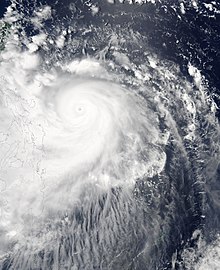 Imbudo approaching the Philippines near peak intensity on July 21 | |
| Meteorological history | |
|---|---|
| Formed | July 15, 2003 |
| Dissipated | July 25, 2003 |
| Very strong typhoon | |
| 10-minute sustained (JMA) | |
| Highest winds | 165 km/h (105 mph) |
| Lowest pressure | 935 hPa (mbar); 27.61 inHg |
| Category 4-equivalent super typhoon | |
| 1-minute sustained (SSHWS/JTWC) | |
| Highest winds | 240 km/h (150 mph) |
| Lowest pressure | 910 hPa (mbar); 26.87 inHg |
| Overall effects | |
| Fatalities | 85 |
| Damage | $383 million (2003 USD) |
| Areas affected | Philippines, China |
| IBTrACS | |
Part of the 2003 Pacific typhoon season | |
Typhoon Imbudo,[nb 1] known in the Philippines as Super Typhoon Harurot,[nb 2][1] was a powerful typhoon that struck the Philippines and southern China in July 2003. The seventh named storm and fourth typhoon of the season, Imbudo formed on July 15 to the east of the Philippines. The storm moved generally west-northward for much of its duration due to a ridge to the north. Favorable conditions allowed Imbudo to intensify, gradually at first before undergoing rapid deepening on July 19. After reaching typhoon status, Imbudo strengthened further to peak 10–minute sustained winds of 165 km/h (103 mph) on July 20. The typhoon made landfall on northern Luzon near peak intensity on July 22, but quickly weakened over land. Once in the South China Sea, Imbudo re-intensified slightly before making its final landfall in southern China near Yangjiang on July 24, dissipating the next day.
In the Philippines, Imbudo was the strongest typhoon in five years, causing widespread flooding and power outages in the Cagayan Valley for weeks. Damage was heaviest in Isabela province near where the storm struck. Most of the banana crop was destroyed, and other crops sustained similar but lesser damage. Imbudo disrupted transportation across much of Luzon. Nationwide, the storm damaged or destroyed 62,314 houses, causing P4.7 billion (PHP, $86 million USD) in damage, mostly in the Cagayan Valley.[nb 3] There were also 64 deaths in the country. In Hong Kong, strong winds killed a man after knocking him off a platform. In China, damage was heaviest in Guangdong where the storm struck. Thousands of trees fell, and 595,000 houses were wrecked. Hundreds of canceled flights stranded travelers across the region. In Guangxi, high rainfall increased water levels in 45 reservoirs to warning levels. In Guangxi and Guangdong, collectively 20 people were killed, and damage reached about ¥4.45 billion (CNY, US$297 million).
Cite error: There are <ref group=nb> tags on this page, but the references will not show without a {{reflist|group=nb}} template (see the help page).
- ^ Super Typhoon "Harurot" (19 to 23 July 2003) (Report). Philippine Atmospheric, Geophysical and Astronomical Services Administration. Archived from the original on 14 October 2013. Retrieved 2013-10-05.